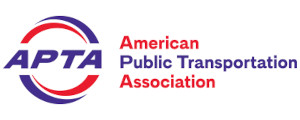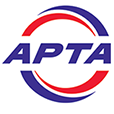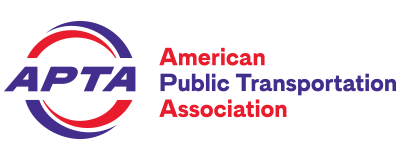The United States is making significant strides toward making High Speed Rail a viable alternative for travel within the United States. The California High Speed Rail Authority, Brightline West and Brightline Florida, Cascadia Rail, Texas Central, and the High Desert Corridor are all projects that have benefited from Federal Investments and Public Private Partnerships (PPP).
The Infrastructure Investment and Jobs Act (IIJA) marked a generational shift in funding for High Speed Rail projects. In May 2025, increasing funding for public transportation was proposed in the Fiscal Year 2026 Budget request. Specifically, the Budget would provide $16.5 billion for passenger and freight rail (when combined with the advance appropriations of the Infrastructure Investment and Jobs Act), $3.8 billion for Capital Investment Grants and 15 new CIG projects in 11 States. The Administration’s proposed FY 2026 Budget follows Congressional passage in March of the Transportation Appropriations Bill for FY 2025. The bill provides $16.2 billion for passenger and freight rail.
APTA is actively reminding the Senate and House that investing in high-speed rail and other public transportation projects will create highly skilled jobs in business and manufacturing throughout the country and revitalize domestic industries supplying transportation products and services.
The following High-Speed Rail Snippets are from High-Speed and Intercity Passenger Rail Newsletter “Speedlines”, Issue 42
- Brightline West officially broke ground in April 2024 on its 218-mile high-speed rail line within the median of the I-15 highway with zero grade crossings. At speeds up to 200 miles per hour, trains are expected to take passengers from Las Vegas to Rancho Cucam
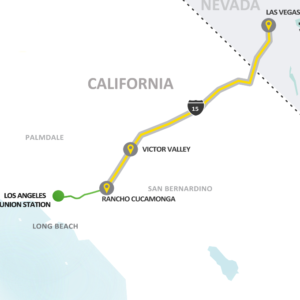 onga in about two hours, twice as fast as the normal drive time.
onga in about two hours, twice as fast as the normal drive time. - Construction is estimated to take four years, and passenger service is expected start in time for the 2028 Los Angeles Summer Olympics and Special Olympics.
- This $12 billion project will be both privately and publicly funded. $3 billion was awarded in IIJA grant funding from FRA, (Funding for Step 1 has not yet been obligated), $3.5 billion was allocated in private activity bonds from USDOT. The remaining costs of the project will be privately funded.
- Brightline is the only private provider of modern intercity passenger rail service in America, this privately led infrastructure project is one of the largest in the nation. All operations and construction will be with union labor.
- It will be fully Buy America Compliant – it will use 700,000 concrete rail ties, 2.2 million tons of ballast, and 63,000 tons of 100 percent American steel rail. Upon completion, it will include 322 miles of overhead lines to power the trains and will include 3.4 million square feet of retaining walls. The project covers more than 160 structures including viaducts and bridges.
- 1996 – The California Legislature passed the High-Speed Rail Act, which formed the California High-Speed Rail Authority (CHSRA) to plan, design, construct and operate a statewide high-speed rail system. The CHSRA was funded entirely by appropriations of the California General Assembly
- 1996 – 2001 – Tiered environmental review process examining both programmatic and project level environmental impacts, which includes, National Environmental Policy Act (NEPA), required by FRA.
- 2001 – The Notice of Intent to Prepare a Programmatic Environmental Impact Statement for the California High Speed Train System
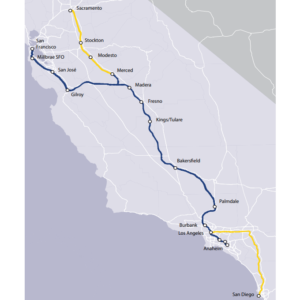
- 2005 – The Record of Decision for the Programmatic Environmental Impact Statement (EIS) was signed by FRA. The Tier 1 EIS document considered, described and summarized the environmental impacts at a programmatic level of analysis for the proposed high-speed train system for intercity travel in California and alternatives that connect the major metropolitan areas of the state from Sacramento, Oakland, San Francisco, and San Jose, through Stockton, Modesto, Merced, Fresno, and Bakersfield, to Los Angeles, Orange County, and San Diego.
- 2007 – CHSRA engaged teams of engineering and environmental consultants to prepare the project level preliminary engineering and environmental clearance documents necessary to propel the project forward.
- 2008 – California voters approved Proposition 1A on November 4, 2008, which authorized the California Transportation Commission to issue $10 billion in bonds upon appropriation by the General Assembly to allocate funds for capital improvements to intercity rail lines, commuter rail lines, and urban rail systems that provide direct connectivity to the high-speed train system and its facilities.
- 2009 – The FRA issued a Notice of Intent to prepare an Environmental Impact Statement (EIS) and Environmental Impact Report (EIR) for the Merced to Bakersfield segment which was later revised to be Merced/Fresno.
- 2014 – The Final EIS and Record of Decision on the Fresno – Bakersfield segment was issued on and the Surface Transportation Board approved the high-speed rail route from Fresno to Bakersfield. This was the final approval needed before beginning construction.
- 2015 – Groundbreaking for the initial construction segment began. Construction was divided into four construction packages and design/build contracts awarded to design/build teams.
- 2018 – California State Rail Plan determined the impact of the high-speed rail line and network travel and how it can reduce the need to expand highways and airports to accommodate the travel needs of a growing population.
- 2024 – The California High-Speed Rail Authority proposed high-speed rail line that would connect San Francisco to Los Angeles/Anaheim, CA. The proposed Corridor would provide new service on a blend of new and existing alignments. Funds for Step 1 of this segment were obligated in March 2024. AECOM is the program delivery management consultant
- 2025 – More than 60 miles of contiguous guideway are complete, making those sections ready for tracklaying. There is another 111 miles of active construction on-going in the Central Valley. CHSRA is seeking proposals from trainset manufacturers and will be procuring rail and electrification system components.
- Federal funding has come from ARRA and IIJA grants totaling $5.9 billion with an additional $1 billion in funding coming from other federal programs. California has generated $22.5 billion in state funding through Proposition 1A bonds and Cap and Trade programs. The total estimated cost of the 171-mile segment connecting Merced and Bakersfield is estimated to cost of $35 billion.
- 2024 – The High Desert Corridor Joint Powers Agency approved a community workforce agreement and a Memorandum of Understanding that pledged to use union labor during the construction, operation and
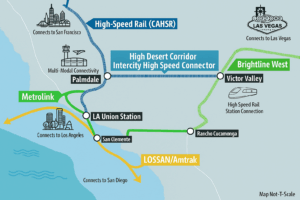 maintenance of the Southern California High Desert Corridor high-speed train project. The 54-mile highspeed rail link would serve as a connector between the planned Brightline West Victor Valley Station and the California high-speed rail station in Palmdale, California.
maintenance of the Southern California High Desert Corridor high-speed train project. The 54-mile highspeed rail link would serve as a connector between the planned Brightline West Victor Valley Station and the California high-speed rail station in Palmdale, California.- 2024 – Funding for Step 1 was obligated and the FRA approved the High Desert Corridor (HDC) Step 1 scope of work, schedule and budget. HDC and LA Metro are developing a HDC Service Development and Funding Plan for 2025. InfraStrategies has been supporting the High Desert Corridor Joint Powers Authority with grant administration and financial planning support services. They have recently advertised for consultant assistance to prepare the service development plan (SDP).
- The Cascadia High-Speed Rail project would connect Seattle to Portland and Vancouver with trains traveling up to 250 mph. The proposed WSDOT high-speed rail corridor includes a potential future extension south to Eugene, OR and would provide new high speed rail service on a new alignment. WSDOT completed Step 1 of the CID.
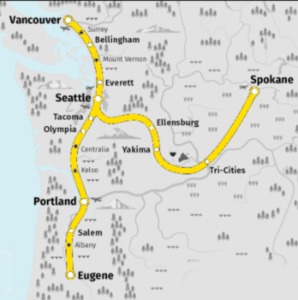
- 2024 – Funding in the amount of $49.7 million was obligated for Step 2 of the CID program for preparing a service development plan (SDP). The federal funding will be supported by $5.6 million from WSDOT. HDR supports a full range of staff augmentation needs and oversees WSDOT’s mega programs.
- 2013 – Texas Central Partners, LLC (TCP), was founded to plan, design, build and operate a high-speed rail service between Dallas and Houston, one of the five high-speed rail corridors identified in the ISTEA era studies. The rail line itself would be owned by the separate Texas Central Railway (TCR).
- Texas Central Partners secured $75 million of private funding to develop the Environmental Impact Statement required by National Environmental Policy Act (NEPA).
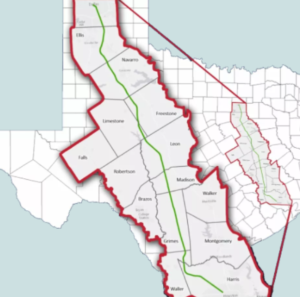
- 2014 – FRA published a Notice of Intent (NOI) to prepare the EIS in the Federal Register. The environmental and social impacts of various alternative high-speed rail route alignments were analyzed including possible routes that share corridors with an existing rail line and along electric utility lines.
- TCR’s proposed high-speed rail line would operate on a dedicated right-of-way with no grade crossings at speeds up to 205 mph and would not share track or infrastructure with existing trains or rail lines. In addition, the EIS analyzed the potential impacts of stations, power or fueling stations, and maintenance facilities to support high-speed rail operations.
- 2020 – FRA released the Final EIS on the Draft Section 106 Programmatic Agreement (Appendix L of Final EIS) and issued the Rule of Particular Applicability (RPA) that established safety standards for the TCR high-speed rail system. The final rule is not intended for general application in the railroad industry but applies only to the TCR system.
- The TCR rolling stock, track, and core systems will replicate the Tokaido Shinkansen system operated by the Central Japan Railway Company. FRA’s Record of Decision (ROD) for the Dallas to Houston Final EIS is contained in the final rule.
- 2020 – The Surface Transportation Board ruled that TCR is part of the interstate rail network based on its through-ticketing with Amtrak, and therefore subject to the STB’s jurisdiction. In June 2022, the Supreme Court of Texas ruled 5–3 that TCR was a railroad and an electric interurban railway under Texas law and has eminent domain authority on land that is needed to build the rail line.
- 2023 – Amtrak partnered with TCR to become the program manager for the project. Amtrak applied to enter the project into the FRA Corridor ID program and was accepted by FRA.
- 2024 – Amtrak completed a Service Development Plan and was awarded a $64 million Corridor ID Project Development grant to continue planning the Texas high-speed rail line as part of the Project Development process.
- 2025 – FRA cancelled the grant based on an agreement between Amtrak and FRA.
- In a statement, the Fort Worth-based investment group Kleinheinz Capital Partners said the company has stepped in as the “private sector sponsor” of the “shovel-ready” project.
- 2012 – Brightline founded (as All Aboard Florida)
- 2018 – Revenue Service between Fort Lauderdale and West Palm Beach began.
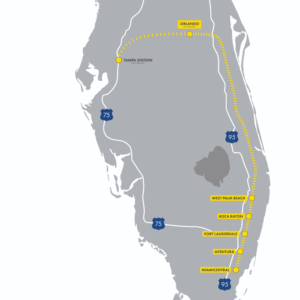
- 2023 – Revenue service between Miami/West Palm Beach and Orlando segment began.
- The Miami/West Palm Beach to Orlando trip, travelling on the 235-mile corridor is approximately 2 hours and 15 minutes, with maximum authorized speeds up to 110 mph on the shared use line segment between Miami and Cocoa Beach and 125 mph on the exclusive right-of-way between Cocoa Beach and Orlando.
- 2024 – Over 3 million passengers utilize the rail service between Miami/West Palm Beach and Orlando. Brightline plans to extend service to Tampa.
- Brightline’s parent company owns the right-of-way and tracks Cocoa Beach and Orlando. Real estate development on land adjacent to stations drives the business model.
